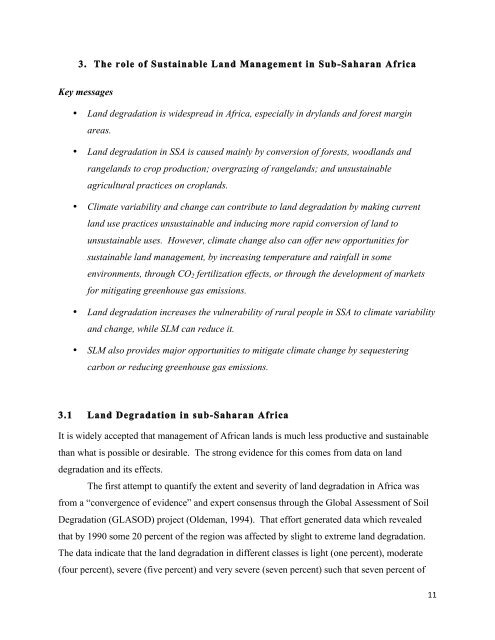The Role of Sustainable Land Management for Climate ... - CAADP
The Role of Sustainable Land Management for Climate ... - CAADP
The Role of Sustainable Land Management for Climate ... - CAADP
You also want an ePaper? Increase the reach of your titles
YUMPU automatically turns print PDFs into web optimized ePapers that Google loves.
!<br />
3. <strong>The</strong> role <strong>of</strong> <strong>Sustainable</strong> <strong>Land</strong> <strong>Management</strong> in Sub-Saharan Africa<br />
Key messages<br />
• <strong>Land</strong> degradation is widespread in Africa, especially in drylands and <strong>for</strong>est margin<br />
areas.<br />
• <strong>Land</strong> degradation in SSA is caused mainly by conversion <strong>of</strong> <strong>for</strong>ests, woodlands and<br />
rangelands to crop production; overgrazing <strong>of</strong> rangelands; and unsustainable<br />
agricultural practices on croplands.<br />
• <strong>Climate</strong> variability and change can contribute to land degradation by making current<br />
land use practices unsustainable and inducing more rapid conversion <strong>of</strong> land to<br />
unsustainable uses. However, climate change also can <strong>of</strong>fer new opportunities <strong>for</strong><br />
sustainable land management, by increasing temperature and rainfall in some<br />
environments, through CO 2 fertilization effects, or through the development <strong>of</strong> markets<br />
<strong>for</strong> mitigating greenhouse gas emissions.<br />
• <strong>Land</strong> degradation increases the vulnerability <strong>of</strong> rural people in SSA to climate variability<br />
and change, while SLM can reduce it.<br />
• SLM also provides major opportunities to mitigate climate change by sequestering<br />
carbon or reducing greenhouse gas emissions.<br />
3.1 <strong>Land</strong> Degradation in sub-Saharan Africa<br />
It is widely accepted that management <strong>of</strong> African lands is much less productive and sustainable<br />
than what is possible or desirable. <strong>The</strong> strong evidence <strong>for</strong> this comes from data on land<br />
degradation and its effects.<br />
<strong>The</strong> first attempt to quantify the extent and severity <strong>of</strong> land degradation in Africa was<br />
from a “convergence <strong>of</strong> evidence” and expert consensus through the Global Assessment <strong>of</strong> Soil<br />
Degradation (GLASOD) project (Oldeman, 1994). That ef<strong>for</strong>t generated data which revealed<br />
that by 1990 some 20 percent <strong>of</strong> the region was affected by slight to extreme land degradation.<br />
<strong>The</strong> data indicate that the land degradation in different classes is light (one percent), moderate<br />
(four percent), severe (five percent) and very severe (seven percent) such that seven percent <strong>of</strong><br />
!<br />
$$!

















